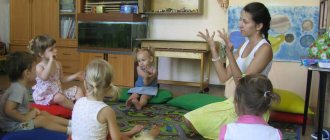To maintain the normal pace of development and health of children, parents should teach their children to perform simple exercises every morning. Morning exercises will help the child wake up and start the metabolic processes necessary to maintain the normal functioning of the body during the day.
By correctly drawing up a schedule of activities for a child and teaching him to perform the complex daily, parents will be able to strengthen his health and instill a love of sports.
The benefits of morning exercises for children 2-5 years old
Morning exercises for children aged 2 to 5 years are useful because they:
- allows the baby to fully wake up;
- charges the little person with energy and vigor for the whole day;
- strengthens the child’s immune system (physical activity increases the body’s resistance to viruses and bacteria spread by airborne droplets);
- minimizes the risk of developing musculoskeletal diseases in a child in adulthood;
- gently forms the correct daily routine necessary for the normal development of the child’s body;
- strengthens character, making him more stubborn and collected (the child, due to the peculiarities of mental development, strives for an exact repetition of the exercise shown by the adult. If he does not succeed, he still continues trying until the desired result is achieved);
- normalizes the child’s weight (parents rarely monitor the overall caloric intake of their child’s diet, which in the vast majority of cases leads to the appearance of excess weight in the little person. With the help of simple exercises, you can adjust the level of daily physical activity of the child, which will ultimately help reduce the risk of developing obesity in future).
Charging for a child 1, 2, 3 years old
Fun gymnastics for children from 1 to 3 years old. Gymnastics for kids
At the age of two or three, children love to imitate adults. Use this quality for useful purposes. You will have to do the exercises together. Just show your child a good example, and he will definitely do everything like mom or dad. “Do as we do, do better than us”! - let these words become the motto of your family.
Gymnastics for kids should not turn into complex strength exercises, push-ups, abdominal swings or acrobatic tricks. It must be carried out for 5-10 minutes, and only in a playful way. Otherwise it won't work. At this age, it is difficult to keep a child’s attention; he needs to be captivated by something. Use and play on topics that are close and understandable to the baby. Don't give all the exercises at once. Two or three are enough for the baby to play and at the same time learn some new motor skills.
CHARGING FOR THE SMALLEST
Get some sunshine. Tell your child that the sun is shining directly above his head (you can hold a yellow balloon in your hands). Ask him to get the sun. He will stretch his arms up and rise on his toes. Here's exercise number 1.
On toes and heels . Ask your child: how can he walk on his toes and heels? Show me how to do it. Let your doll or favorite soft toy take part and show off their skills.
Squats. How to teach a child to squat? Scatter different objects (or toys) around the room and ask your baby to bring them to you one at a time and put them, for example, in a box. The conditions of the game will “force” him to squat.
Bridge. This bridge is different from an adult one because it is performed in reverse. The baby should stand on his hands and feet, but not with his stomach, but with his back up. Make sure he straightens his knees. Look into the baby’s face and ask: “Who became our bridge?”
Little engine . Let the child get down on all fours and show how the locomotive rides. You can accompany the movements with the sounds: “chug-chug.” Mark the trajectory of the “locomotive” and let it try to reverse.
Airplane. Spread your arms out to the sides and fly around the room. Accompany your movements with the sounds of a flying airplane: “oo-oo-oo.”
Scissors . This is a classic exercise that we all know well. A child’s abdominal muscles are not yet strong enough to support their legs for a long time. He will have his own “scissors”. The main thing is effort!
Kitty. Have your baby get on all fours and arch his back up and down, like a cat. Don't forget to purr!
The bear is clubfooted . Ask your child: “How does the bear walk?” Let him show. Demonstrate the clumsy movements of a clubfoot.
Running and jumping. Sprinting for a two-year-old toddler will most likely end in a fall. Learn to run fast gradually. For good coordination of movements and balance, invite your baby to run between placed objects. After running, do some jumping. This won’t be too difficult: ask your child to show how a hare jumps.
PREVENTION OF FLAT FOOT. To prevent flat feet, do foot exercises.
◈ Sit your baby on the floor and invite him to be a monkey. Scatter various (small) objects around and ask the baby to collect them with his toes. Show me how to do it. The task will not be easy!
◈ Sit on the floor (on a soft surface) opposite each other, hold a towel (or clothing) between your legs and play tug of war.
◈ Sit on the floor, pass the ball to each other, pushing it with your feet.
◈ Let the baby raise his arms up, stand on his toes and walk several circles around the room. This exercise trains the muscles of the lower leg and foot well.
Let's move to the songs
If desired, any children's song can be used as musical accompaniment, as well as prompts for action when performing exercises. For example, this one:
Ah, in Africa the mountains are so high (we raise our hands up)
Ah, in Africa the rivers are this wide (we raise our arms to the sides)
Ahh, crocodiles, hippos, (clap our hands)
Ahh, monkeys, sperm whales,
Ahh, and a green parrot (we wave our arms like birds)
Similar articles:
Which sport should a 4-5 year old child choose?
Children's poems for children from birth to 2 years
Charging for a child 3, 4, 5 years old
Toys for children from 1 to 3 years old
Dance lessons for children
How to organize exercises for kids
Exercise for babies should be organized in accordance with the key recommendations of pediatricians:
- Physical education classes should be carried out every day at the same time, with the exception of days of illness (this is how the child develops a habit);
- it is appropriate to include a set of exercises in the child’s daily routine after morning hygiene procedures, but no less than 30 minutes before the first meal;
- select exercises in accordance with the age of the children (for children under 3 years old, complex exercises will not arouse interest, but, on the contrary, will provoke the emergence of negative emotions. For children over 3 years old, it is advisable to include moving loads in the complex that require frequent changes in the pace of the activity);
- carefully monitor the correct execution of exercises to avoid injury to the child;
- Explain to kids the rules of breathing during sports (you need to exhale when making an effort, inhale when relaxing the muscles);
- the complexity of exercises within one complex should increase gradually (otherwise, exercises can lead to overtraining of the muscles and, as a result, pain in the muscles of the child’s body);
- do not force children to play sports, but look for reasons that are more significant for a particular child to perform a set of exercises based on age every day.
Examples of exercise therapy for children 2 years old
In order to improve walking, you can use various exercises. If at this age the baby is still unsteady on his feet, then try to encourage him to move along the furniture. When he stands next to the sofa, start luring him with a bright toy, bringing it closer to him and away from him. You can repeat this exercise up to 4 times, depending on your interest.
If you have achieved the necessary progress, you can begin to complete more complex tasks. The first of these will be walking “on a narrow bridge.” To do this, you will need ropes or sticks, with the help of which the path will be built. At first its width will be 30 cm, but gradually it needs to be narrowed. The baby will have to walk along it without stepping on ropes or sticks, maintaining balance.
The next most difficult exercise is walking on an inclined path. To do this you will need a bench or board. One end of it is placed 20-30 cm higher than the other. The child, with the help of an adult teacher, must alternately rise and fall along the surface.
The following group of exercises helps develop a sense of balance
To complete the first task you will need a rocking horse. There is no need to make any special effort on the part of the student. An adult teacher or family member needs to gently rock the horse. This can also be done on regular swings and carousels.
Experienced specialists have one more effective exercise in physical education. It is very simple, but effective. Under the pretext of finding a toy, you invite the baby to climb onto the sofa. Further, the complex can be complicated by asking you to climb higher.
Examples of exercises for arms and shoulders
Morning exercises help kids develop their shoulder joints and stretch the muscles of their arms and shoulders.
To do this, it is recommended to include the following exercises in the complex:
| Exercises for arms and shoulders | Correct way to do it |
| "Towards the Sun" |
|
| "Swing" |
|
| "Catch flies!" |
|
| Tilts |
|
Physical activity of infants
Already from the second week of life, doctors prescribe basic physical exercises to strengthen the neck muscles and develop the grasping reflex. This is complemented by stroking movements of the legs, arms and back. Such actions help the baby, who has not yet mastered his own body, to organize his movements. Such gymnastics, in addition to the obvious advantages, also has a positive effect:
- to strengthen the muscle corset;
- crawling and walking reflexes;
- improvement of blood circulation and metabolic processes;
- development of the psyche and intellect;
- sensory perception and speech;
- baby's peace of mind.
development of coordination;
In the second month of life, therapeutic physical education and massage are introduced; in the third, exercises are added to all of the above to stimulate the baby to move independently.
Examples of leg exercises
During exercise, children’s legs can be worked out with the following exercises:
| Leg exercises | Correct way to do it |
| Running with overwhelm |
|
| "Heron" | Invite the children to turn in the direction of travel, looking at the back of the person in front. Move in a circle, raising your knees high. The exercise should be performed at an average or slow pace. |
| Swing your legs right and left with support |
|
| "Snake" |
You can make the exercise more difficult by asking your child to run with a book in his hands or jump throughout the entire distance. In order for children to be involved in sports for as long as possible, it is recommended to alternate the mentioned load options. |
Second set of exercises
Boy doing morning exercises
"The trees are swaying"
IP - legs wider, arms at the top. Tilt your torso to the left - you need to take a deep breath, then return to IP - exhale. Now lean to the right - make sure that the baby inhales well and returns to the IP - exhale. This needs to be done 5 times in each direction.
"Geese-geese"
Legs wider, hands on the waist. You need to lean forward, hissing like a goose, “Sh-sh-sh.” You will be able to exhale voluntarily. Then you need to inhale and straighten up into the IP. Do this 6 times.
"We're going down the path"
IP - lie on your back on a mat-mat, straighten your arms and legs. Now you need to alternately bend your legs at the knee joints, as if you were pedaling a bicycle. Place your feet on the floor, then repeat the position again. Do this 3 times, alternating inhalation and exhalation.
"Little Log"
IP - lie on your back, arms up and on the mat. You need to roll over onto your tummy, then back into the PI position. You need to roll like this on the floor for 30 seconds.
"Ball Jumping"
The baby should make arbitrary jumps in one place, to the sides, on both legs and on one leg alternately. You need to do this for 2 minutes.
"The Soldier Walks"
Show your child how soldiers march, clearly raising their knees. Walking should be rhythmic for 2 minutes.
Important: Monitor your child while performing positions. Posture should be beautiful and even. Be sure to turn on rhythmic music so that the child is interested in studying. Each position should be carried out in the form of a game, and the child should be the main character of such a scene.
You can also turn on a video for your child and let him repeat the exercises after the animals or trainers. It’s good if mom or dad joins in the gymnastics, because it’s more fun together.
Exercises for the torso
To work the child’s torso muscles, it is recommended to perform exercises such as:
| Leg exercises | Correct way to do it |
| "Castle" |
|
| "Adjuster" |
It is not recommended to pause while performing the approach. |
| "Bunnies" |
|
Stretching exercises
To develop the flexibility of a child’s body, at the final stage of charging, it is recommended to perform special exercises that increase the elasticity of the muscles.
| Leg exercises | Correct way to do it |
| "Cat dog" |
|
| Forward bends |
|










